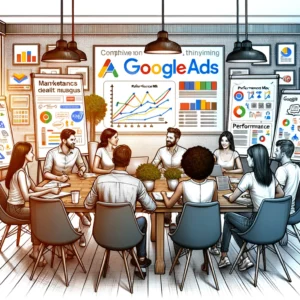Google Ads has undergone significant transformations recently, shifting the landscape of pay-per-click (PPC) advertising. Marketers clinging to older strategies might find these less effective in today’s digital advertising environment.
We have insights to share on how businesses can optimize their ad campaigns using the latest features over the next 12 months.
One of the most notable innovations in Google Ads is Performance Max (PMax), which has stirred mixed feelings in the marketing community.
Understanding Performance Max:
Performance Max is a goal-based, AI-driven advertising solution that allows advertisers access to Google’s extensive ad inventory across platforms like Display, Video, Search, Gmail, and Maps. Its AI capabilities extend to bidding, budget optimization, audience targeting, and creative attributions based on the advertiser’s goals, typically focused on conversions. PMax efficiently utilizes your creative assets and data to target potential customers at various funnel stages, optimizing for the highest conversion opportunities.
Caveats and Best Practices:
Despite its advantages, PMax requires adequate budgeting and time to perform optimally. We generally recommend a minimum monthly ad spend of $3,000, as the AI needs substantial data to fine-tune its strategies. Moreover, while it might be tempting to provide PMax with specific audience signals, broader parameters often yield better results, preventing the algorithm from being overly restrictive and missing potential opportunities.
It’s crucial to have robust conversion tracking in place. PMax optimizes for conversions, and without accurate tracking, it could focus on low-value actions. Also, providing high-quality creative, especially video content, significantly enhances the effectiveness of your ads. Although PMax can generate videos automatically, professionally produced videos usually perform better.
Advanced Ad Formats:
In addition to PMax, Responsive Search Ads (RSAs) and Dynamic Search Ads (DSAs) are powerful tools for modern marketers. RSAs allow you to input multiple headlines and descriptions, with Google testing various combinations to find the most effective ones. DSAs target keywords based on your website content, ideal for large inventories where manually creating ads for every item isn’t feasible. For businesses looking to stay ahead, it’s essential to transition from older ad formats to these newer, more efficient models.
Consider using broad audience targeting in your PMax campaigns unless you observe poor-quality conversions. Also, integrating top, middle, and bottom of the funnel campaigns into a single PMax campaign can provide the AI with more data, enhancing its decision-making process.
 Remember, while AI and advanced technologies provide powerful tools for testing and optimizing, the fundamentals of advertising still apply. Regular updates to your ad copy and creative are necessary, and the success of your ads will ultimately depend more on the quality of your offer and your website than on any specific targeting tweaks.
Remember, while AI and advanced technologies provide powerful tools for testing and optimizing, the fundamentals of advertising still apply. Regular updates to your ad copy and creative are necessary, and the success of your ads will ultimately depend more on the quality of your offer and your website than on any specific targeting tweaks.
Embracing these new Google Ads technologies can significantly improve your campaign performance. However, success requires not only understanding these tools but also integrating them thoughtfully with traditional marketing principles.
For more personalized advice, consider a free website and marketing review at WSI, where we can also provide a bespoke analysis of your Google Ads performance.



